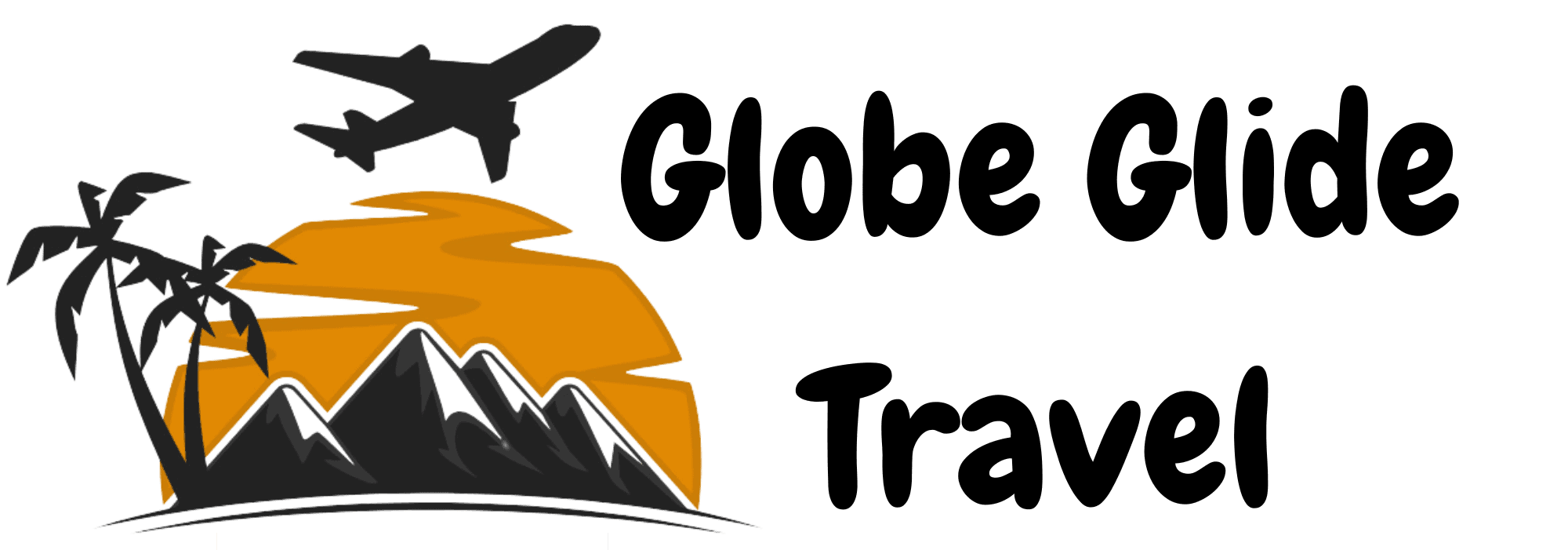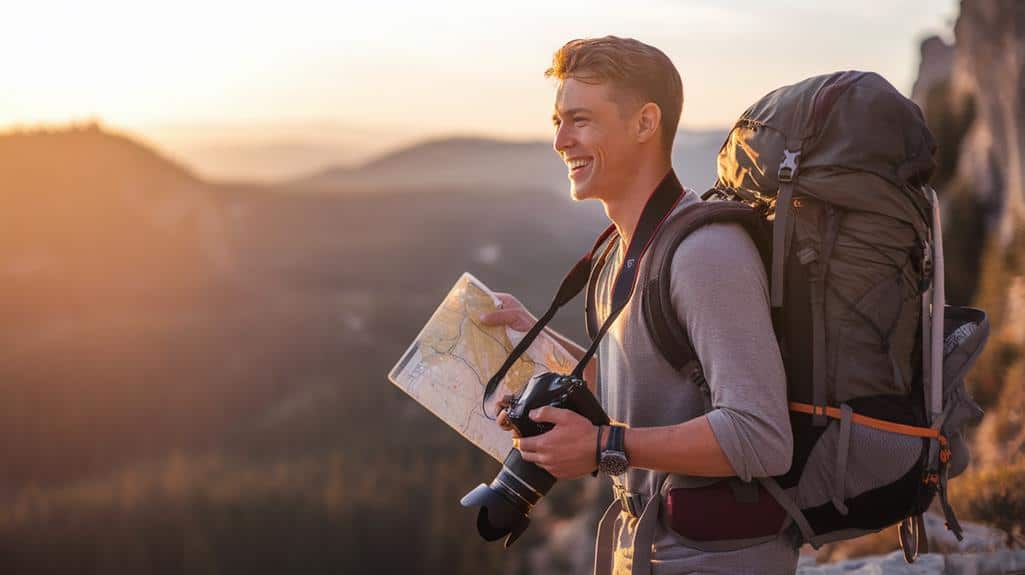
7 Essential Travel Photography Tips for Newbie Explorers
Master your camera's basic settings, including the exposure triangle (aperture, shutter speed, ISO), to achieve ideal results. Prioritize composition by employing techniques like the rule of thirds and leading lines. Capture local culture respectfully, seeking authentic experiences at markets and festivals. Experiment with different perspectives, shooting from low or high vantage points and utilizing reflections. Pack versatile gear, including a camera with manual controls and interchangeable lenses. Optimize natural light usage, especially during golden hour for warm, soft tones. Finally, edit and organize your photos using management software for basic adjustments and efficient cataloging. These essential tips will elevate your travel photography, but there's always more to explore in this engaging art form.
In a Nutshell
- Master basic camera settings, including the exposure triangle and shooting modes.
- Prioritize composition using techniques like the rule of thirds and leading lines.
- Capture local culture respectfully, seeking authentic experiences and using natural light.
- Experiment with different perspectives, including low angles, reflections, and unconventional framing.
- Pack essential gear, including versatile lenses, a tripod, and filters for various shooting scenarios.
Master Your Camera's Basic Settings
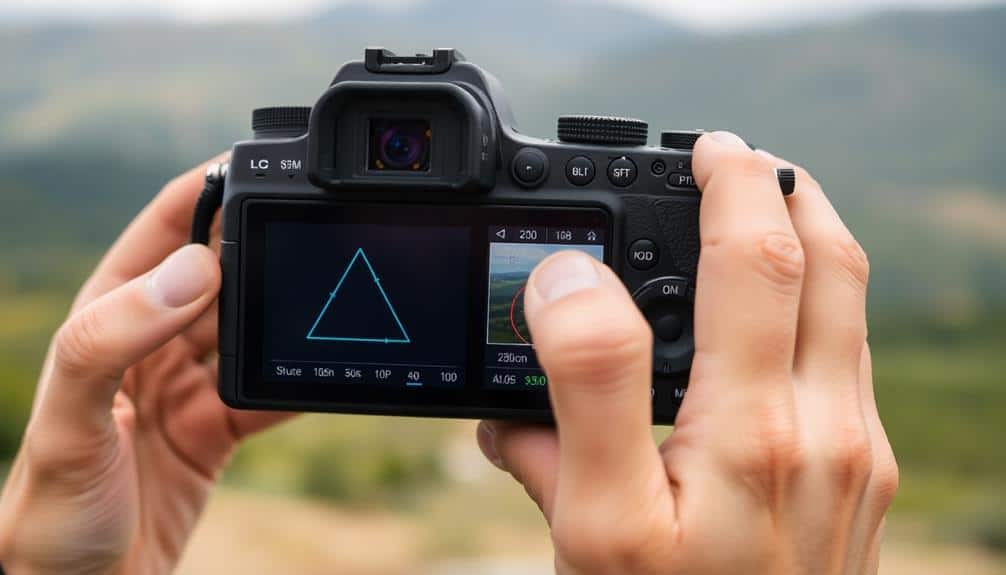
Diving into photography can be overwhelming, but mastering your camera's basic settings is essential for capturing stunning travel shots. Start by familiarizing yourself with the exposure triangle: aperture, shutter speed, and ISO. Aperture controls depth of field, shutter speed affects motion blur, and ISO determines light sensitivity. Experiment with these settings to achieve the desired effect in various lighting conditions. When choosing a travel camera, consider factors like portability, versatility, and image quality to guarantee you have the right tool for your adventures.
Next, learn to use your camera's different shooting modes, such as Aperture Priority, Shutter Priority, and Manual. Each mode offers unique advantages for different scenarios. Don't forget to explore white balance settings to guarantee accurate color reproduction in your images. Additionally, practice using focus modes and metering options to achieve sharp, well-exposed photographs. By understanding and utilizing these basic settings, you'll be well-equipped to capture memorable travel moments with confidence and precision.
Prioritize Composition and Framing
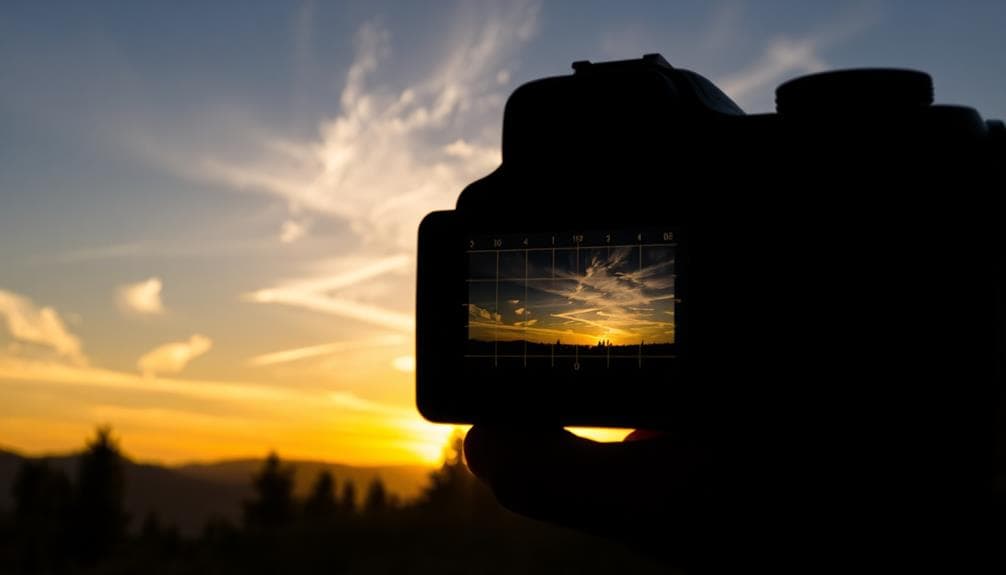
The art of composition and framing can elevate your travel photography from ordinary to extraordinary. When composing your shots, ponder the rule of thirds, which divides your frame into a 3×3 grid. Place key elements along these lines or at their intersections for a more balanced and visually appealing image. Pay attention to leading lines, natural elements that draw the viewer's eye through the photograph. Using a travel tripod can greatly enhance your ability to compose shots, especially in low-light conditions or when using slower shutter speeds. To enhance your framing skills:
- Use natural frames like archways or tree branches
- Experiment with different perspectives and angles
- Incorporate foreground elements for depth
- Balance negative space with your subject
Remember to think about the background, ensuring it complements rather than distracts from your main subject. By prioritizing composition and framing, you'll create more compelling travel photographs that effectively capture the essence of your destinations and experiences.
Capture Local Culture and People

Capturing local culture and people is at the heart of truly immersive travel photography. To achieve this, you'll need to approach your subjects with respect and sensitivity. Always ask for permission before photographing individuals, and be prepared to explain your intentions. Seek out authentic experiences by visiting local markets, festivals, and traditional events. These settings offer rich opportunities to document daily life and customs. For a more thorough approach, consider consulting insider travel tips from experienced photographers and local experts to uncover hidden gems and unique cultural experiences. When composing your shots, consider including environmental elements that provide context and tell a story. Utilize natural light whenever possible to capture genuine moments without disrupting the scene. Don't shy away from candid shots, but be mindful of cultural norms and privacy concerns. Experiment with different focal lengths to capture both intimate portraits and wider scenes that showcase the relationship between people and their surroundings. Remember, patience and observation are key to capturing meaningful images that reflect the essence of a place and its inhabitants.
Experiment With Different Perspectives
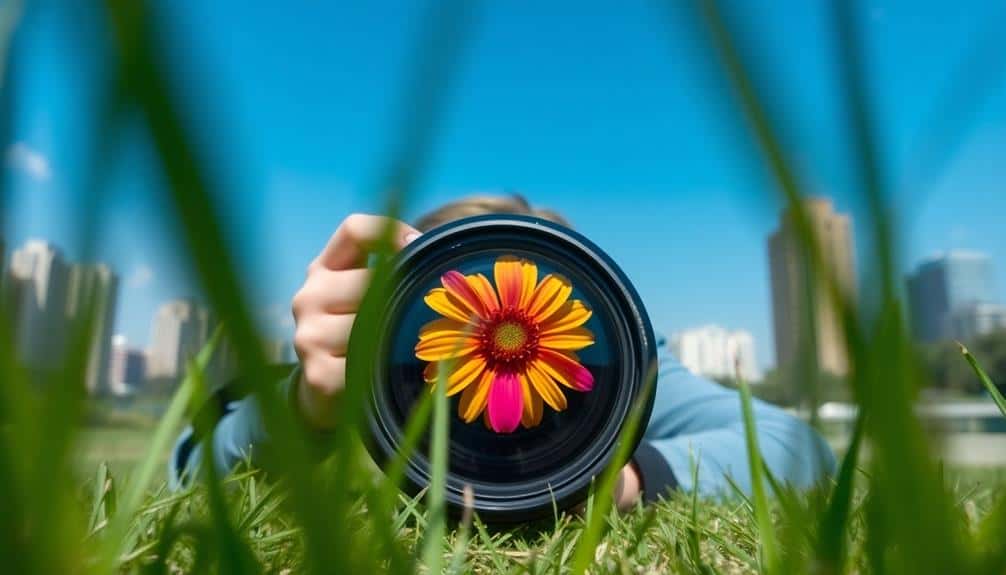
Creativity flourishes when you experiment with different perspectives in travel photography. By changing your viewpoint, you'll capture unique images that stand out from typical tourist shots. Consider these techniques to enhance your compositions:
- Get low to the ground for a worm's-eye view
- Climb to higher vantage points for bird's-eye perspectives
- Utilize reflections in water or mirrors for symmetrical compositions
- Shoot through objects to create natural frames
When photographing landmarks, move around to find less-common angles. Try tilting your camera for dynamic diagonal lines, or use a wide-angle lens to exaggerate foreground elements. Experiment with zooming in on architectural details or patterns. Don't be afraid to break composition rules; sometimes, unconventional framing yields the most striking results. Remember, changing your perspective isn't just about physical positioning; it's about seeing the world through fresh eyes.
Pack the Right Gear
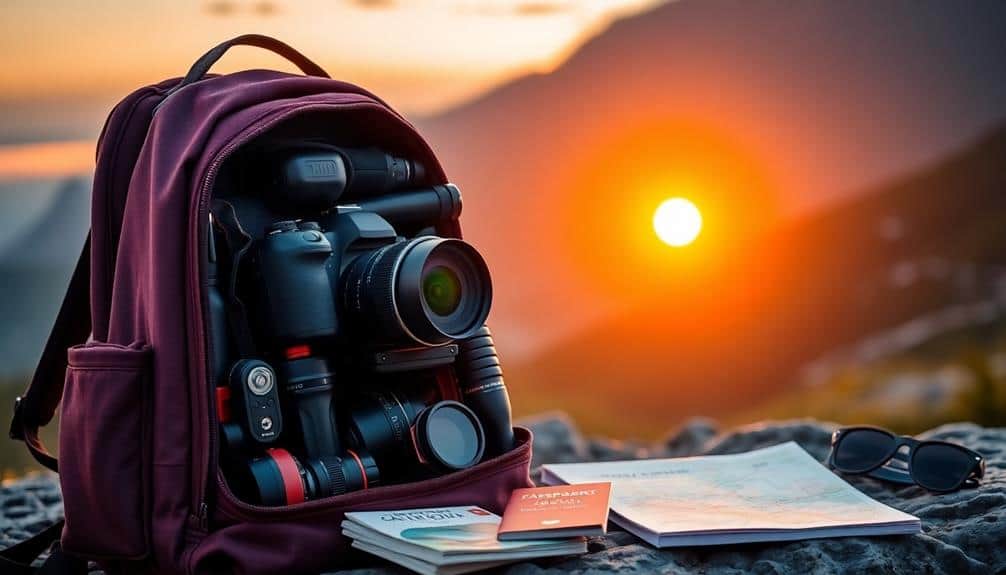
While experimenting with perspectives can yield alluring images, you'll need the right tools to bring your creative vision to life. Start with a versatile camera body that offers manual controls and interchangeable lenses. A wide-angle lens (16-35mm) is essential for capturing sweeping landscapes, while a telephoto lens (70-200mm) allows you to zoom in on distant subjects. Don't forget a sturdy tripod for low-light situations and long exposures.
Pack a selection of filters, including polarizers to reduce glare and enhance colors, and neutral density filters for creative effects. A remote shutter release will minimize camera shake during long exposures. Guarantee you have sufficient memory cards, spare batteries, and a reliable camera bag to protect your gear. Consider bringing a lightweight, portable flash for fill lighting in challenging conditions. With this well-rounded kit, you'll be prepared for various photographic opportunities during your travels.
Optimize Natural Light Usage
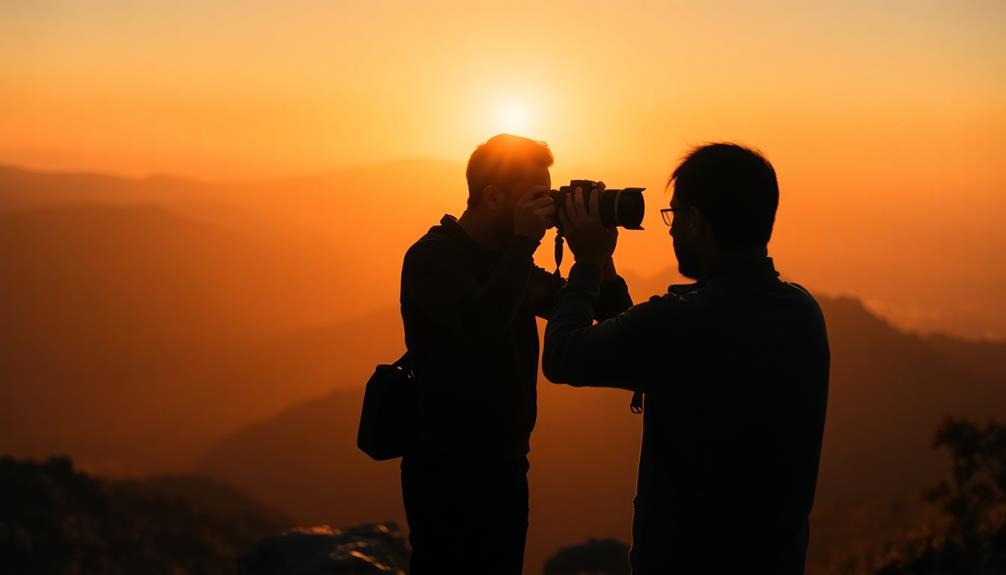
To truly elevate your travel photography, mastering the use of natural light is essential. Understanding how light changes throughout the day will greatly impact your images' quality and mood. During the "golden hours" of sunrise and sunset, you'll capture warm, soft light that adds depth and dimension to your subjects. Midday light can be harsh, creating strong shadows, but it's ideal for capturing vibrant colors and textures.
To optimize natural light usage:
- Use the sun as a backlight for dramatic silhouettes
- Position subjects near windows for soft, diffused indoor lighting
- Experiment with side-lighting to create depth and texture
- Utilize reflective surfaces to bounce light onto your subject
Always be aware of your surroundings and how light interacts with the environment. By mastering natural light techniques, you'll consistently produce stunning travel photographs that truly capture the essence of your adventures.
Edit and Organize Your Photos
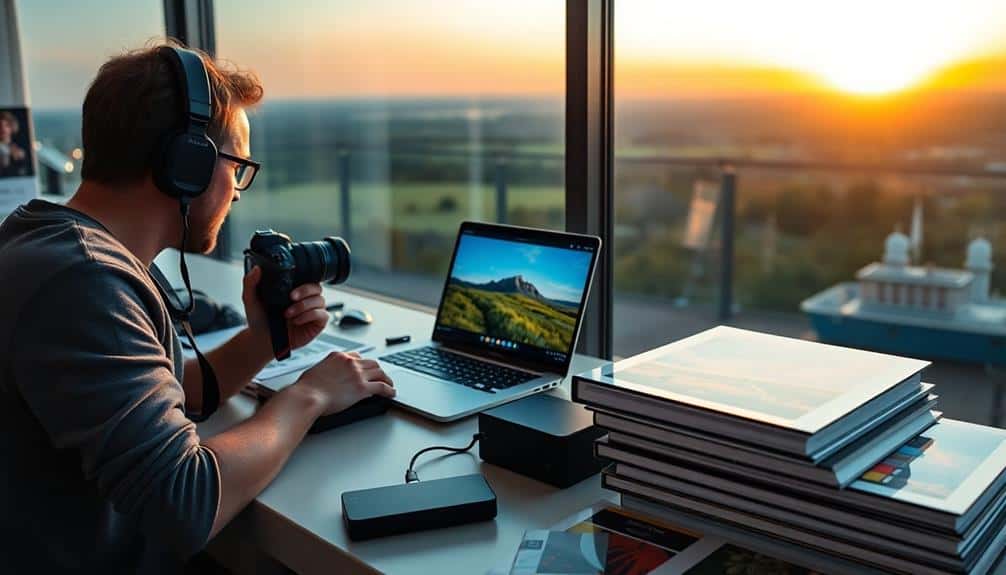
After capturing your stunning travel photos, the next step is to enhance and manage your visual memories. Start by importing your images into a reliable photo management software, such as Adobe Lightroom or Capture One. These programs allow you to organize your photos by date, location, or custom tags, making it easier to locate specific shots later. When editing, begin with basic adjustments like exposure, contrast, and white balance. Don't overdo it; aim for natural-looking enhancements that preserve the authenticity of your travel experiences. For more advanced edits, consider using selective adjustments to fine-tune specific areas of your images. Once you're satisfied with your edits, export your photos in high-quality formats and create backups on external hard drives or cloud storage services. This methodical approach guarantees your travel memories are preserved and easily accessible for years to come.
Frequently Asked Questions
How Do I Protect My Camera Equipment From Theft While Traveling?
Like a fortress guards its treasures, you must protect your camera gear from prying hands. Never leave your equipment unattended, and use a sturdy, inconspicuous camera bag. Invest in travel insurance that covers theft, and consider using cable locks to secure your bag. When possible, utilize hotel safes or lockers. Be discreet when shooting in crowded areas, and always keep your gear close. Consider using GPS trackers for expensive items, and backup your photos regularly to prevent loss of memories.
What's the Best Way to Back up Photos During a Trip?
To effectively back up your photos during a trip, you'll want to employ multiple strategies. First, use a portable external hard drive to create daily backups of your images. Additionally, consider cloud storage services like Google Drive or Dropbox for an off-site backup solution. If you're carrying a laptop, utilize its storage as well. For added security, you can use memory cards with built-in Wi-Fi to automatically upload photos to your smartphone or tablet, ensuring redundancy across several devices.
Are There Legal Restrictions on Photographing Certain Landmarks or Locations Abroad?
You'd think snapping photos of the Eiffel Tower at night was harmless, but surprise! It's actually illegal. Many countries have restrictions on photographing certain landmarks, military installations, and even public spaces. Before your trip, research local laws to avoid unintentional violations. Some places require permits, while others prohibit photography outright. Be particularly cautious around government buildings, airports, and religious sites. When in doubt, ask permission or refrain from taking photos to respect local customs and laws.
How Can I Take Great Photos Without Disturbing Locals or Being Disrespectful?
To take great photos without disturbing locals or being disrespectful, you'll need to be mindful of cultural sensitivities. Always ask for permission before photographing individuals, especially in more conservative areas. Be aware of local customs and dress codes, respecting religious sites and ceremonies. Use a zoom lens to capture candid shots from a distance, and avoid using flash in crowded areas. When possible, learn a few phrases in the local language to establish rapport and show respect for the community you're photographing.
What's the Ideal Camera Insurance for International Travel Photography?
You might think camera insurance is unnecessary, but it's essential for international travel photography. The ideal insurance should cover theft, accidental damage, and loss, with worldwide coverage. Look for policies that offer replacement cost coverage, not just actual cash value. Consider add-ons for rental equipment and liability protection. Compare deductibles, claim processes, and coverage limits. Some providers, like PPA or TCP, specialize in photography gear. Don't forget to check if your homeowner's or renter's insurance already provides some coverage.
